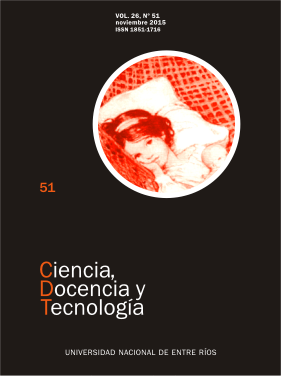Abstract
This article aims to examine the differences between the terminologies used in the legal framework for international relations of Entre Ríos Province and those prevailing in the specialized academic literature. It argues that citizenry consciousness concerning the usefulness of paradiplomacy as a public policy tool to promote space development is associated with linguistic and communicational features. This study takes into consideration the internal and external conditions to which the main opportunities and dilemmas for the international integration of Entre Ríos are related.
References
AGUIRRE ZABALA, Iñaki (2001). ¿Qué sentido tiene hablar de paradiplomacia? Una encuesta intertextual entorno a un neologismo polisémico. En Aldecoa Luzarraga, Francisco y Keating, Michael. Paradiplomacia: las relaciones internacionales de las regiones. Madrid: Marcial Pons.
BACHELARD, G. (1984). La formación del espíritu científico. Buenos Aires: Siglo XXI.
BULL, H. (1977). The anarchical society: a study of world order in world politics. Londres: Macmillan.
CALVENTO M. (2010), “La Cooperación Internacional Descentralizada en los municipios intermedios de Argentina”, V Congreso Latinoamericano de Ciencia Política. Asociación Latinoamericana de Ciencia Política, Buenos Aires, 2010. http://www.aacademica.com/000-036/454.pdf
COLACRAI, M. (2013), “El rol de las ciudades en el actual escenario internacional y en los procesos de integración regional: ni tanto, ni tan poco…”, Revista de Integración y Cooperación Internacional nº14, Enero-Marzo, CERIR-UNR, Rosario.
COLACRAI, M. y G. ZUBELZÚ, G. (2004), “Las vinculaciones externas y la capacidad de gestión internacional desplegadas por las provincias argentinas en la última década. Una lectura desde las relaciones internacionales.” CARI, Buenos Aires.
COLACRAI, M. y G. ZUBELZÚ. (1994), “Las provincias y sus relaciones externas. ¿Federalización de la Política Exterior o protagonismo provincial en las relaciones internacionales?”Cuadernos de Política Exterior, UNR-CERIR, Rosario
CORNAGO PRIETO, N. (1999). “Diplomacy and Paradiplomacy in the Redefinition of International Security: dimensions of conflict and cooperation”, en Aldecoa F. y M. Keating (editors) Paradiplomacy in Action. The Foreign Relations of Subnational Governments. Portlando: Frank Cass Publishers
CORNAGO PRIETO, N. (2010). “La descentralización como elemento de innovación diplomática: aproximación a sus causas estructurales y lógicas de acción”, en L. Maira, La Política Internacional Subnacional en América Latina (págs. 107-134). Buenos Aires : Libros del Zorzal.
CRIEKEMANS, D. (2010), “Foreign Policy and Diplomacy of the Belgian Regions: Flanders and Wallonia, Discussion Papers in Diplomacy, Netherlands Institute of International Relations Clingendael.
DESCARTES, R. (2006). Discurso del método. Buenos Aires: Gradifco.
DRNAS DE CLÉMENT, Z. “Aspectos internacionales de la participación de los poderes locales en los procesos de integración”, en Martín López y Oddone (coord.) Las ciudades y los poderes locales en las relaciones internacionales contemporáneas, Granada, 2010, p. 244
DUCHACEK, I. (1990), “Perforated Sovereignties: Towards a Typology of New Actors in International Relations”, en Michelmann, H. J. and Soldatos, P. Federalism and International Relations. The Role of Subnational Units, Oxford, Clarendon Press, 1990.
DUCHACEK I. (1986), The Territorial Dimension of Politics: Within, Among, and Across Nations, Westview Press, Boulder and London.
HOCKING, B. (2012). Futures for Diplomacy: Integrative Diplomacy in the 21st Century.Clingendael.
HOCKING, B. (1995), “Bridging Boundaries: Creating Linkages. Non-Central Governments and Multilayered Policy Environments”, WeltTrends 11, pp. 36-51
IGLESIAS, E., Iglesias, V., &Zubelzú., G. (2008). Las Provincias Argentinas en el escenario internacional. Buenos Aires: PNUD - CARI.
KANT, I. (2004). Crítica de la razón puta. Buenos Aires: Libertador.
KEOHANE, R. y J. NYE (1998). Poder e interdependencia: la política mundial en transición.Buenos Aires: GEL.
HERNÁNDEZ, A. M. (2010). Los aspectos financieros y económicos del federalismo argentino. Córdoba: Anales de la Academia Nacional de Derecho y Ciencias Sociales de Córdoba, Tomo 49, 2010, págs. 165-198
KINCAID, J. (1990), “Constituent Diplomacy in Federal Polities and the Nation- State: Conflict and Co-operation," en Hans J. Michelmann and PanayotisSoldatos, eds.,Federalism and International Relations: The Role of Subnational Units, New York: OxfordUniversity Press, pp.54-75
LUCKMANN, P. B. (1968). La construcción social de la realidad. Buenos Aires: Amorrortu.
ODDONE, N., “Una paradiplomacia transfronteriza para la geografía de la(s) América(s) Latina(s)”, en Zeraoui Z. Teoría y Práctica de la Paradiplomacia, Tecnológico de Monterrey, Montiel & Soriano, Puebla, 2013, p. 136
PRIETO, N. C. (2010). La descentralización como elemento de innovación diplomática. En L. Maira, La Política Internacional Subnacional en América Latina (págs. 107-134). Buenos Aires: Libros del Zorzal.
ROSENCRANCE, R. (1987). La expansión del Estado comercial. Madrid: Alianza.
RUSSELL, R. (2010). El Estado nación y los actores gubernamentales no centrales: una relación complementaria. En L. Maira, La Política Internacional Subnacional en América Latina (págs. 83-106). Buenos Aires: Libros del Zorzal.
SALVIOLO, M. (2005). Provincias y Convenios Internacionales. Una propuesta desde el Federalismo de Concertación. Buenos Aires: Nuevo Hacer-GEL.
SARTORI, G. (1995). La Política: lógica y método en las ciencias sociales. México: Fondo de Cultura Económica.
SEN, Amartya. Development as Freedom. Oxford UniversityPress.
SCHIAVON, J. (2010), “Las relaciones exteriores de los gobiernos estatales: el caso de México”, en Maira L. La política internacional subnacional en América Latina, Libros del Zorzal, Buenos Aires.
SODUPE, K. La teoría de las Relaciones Internacionales a comienzos del siglo XXI. Zarauts: Servicio Editorial de la Universidad del País Vasco.
WENDT, A. (1992). Anarchy is what states make of it: the social construction of power politics. International Organization , 391-425.
UGALDE ZUBIRI, A. (2005) La acción exterior de los gobiernos no centrales en la Unión Europea ampliada, Instituto Hegoa, Universidad del País Vasco, Bilbao. Disponible en: http://www.ehu.eus/cursosderechointernacionalvitoria/ponencias/pdf/2005/2005_1.pdf
ZERAOUI, Z. (2013), “La paradiplomacia y las relaciones internacionales de las regiones”, en Zeraoui Z. (coord.) Teoría y Práctica de la Paradiplomaica, Montiel & Soriano, Puebla, pp. 9-43
The authors retain the copyright and grant the journal the right to be the first publication of the work, as well as licensing it under a Creative Commons Attribution License that allows others to share the work with an acknowledgment of the authorship of the work and publication initial in this magazine. All content is published under the Creative Commons 4.0 international license: Attribution-Non-Commercial-Share Alike.

